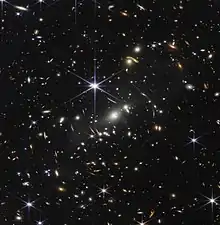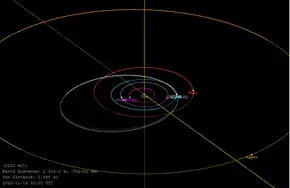 Orbit before impact | |
| Discovery[1][2] | |
|---|---|
| Discovered by | David Rankin (Mt. Lemmon Srvy) |
| Discovery site | Mt. Lemmon Obs. |
| Discovery date | 19 November 2022 |
| Designations | |
| 2022 WJ1 | |
| C8FF042[3][4] | |
| NEO · Apollo[1] | |
| Orbital characteristics[5] | |
| Epoch 9 August 2022 (JD 2459800.5) | |
| Uncertainty parameter 6 | |
| Observation arc | 3.04 hours[1] |
| Aphelion | 2.817 AU |
| Perihelion | 0.928 AU |
| 1.872 AU | |
| Eccentricity | 0.5043 |
| 2.56 yr (935.9 days) | |
| 310.198° | |
| 0° 23m 4.778s / day | |
| Inclination | 2.582° |
| 56.748° | |
| May 2020 (last perihelion)[6] 16 December 2022 (would have been)[5] | |
| 35.034° | |
| Earth MOID | 0.000256 AU (38,300 km; 0.100 LD)[lower-alpha 1] |
| Jupiter MOID | 2.418 AU |
| Physical characteristics | |
Mean diameter | <1 m[lower-alpha 2] |
| ≈31 @ 0.2 AU[7] ≈15 (before entering Earth's shadow)[1] | |
| 33.554±0.363[5] | |
2022 WJ1, formerly designated C8FF042, was a small, harmless ≈1-metre near-Earth asteroid or meteoroid that impacted Earth's atmosphere on 19 November 2022 at 08:27 UT in Southern Ontario, Canada, above the Golden Horseshoe region, southwest of Toronto.[4][8][9] Meteorites were detected by weather radar during dark flight.
Discovery
The asteroid was discovered three hours before impact by David Rankin at Mount Lemmon Observatory, during routine observations for the Mount Lemmon Survey.[2] The first image was taken at 04:53 UT when the asteroid was 0.000859 AU (128.5 thousand km; 79.8 thousand mi; 0.334 LD) from Earth.[10] Using the first four images of the asteroid, Scout estimated a 25% chance of an Earth impact.[11] The next four images raised the chance to 50%. Within about an hour, further observations raised the chance of impact to 100%. The final observation was from Mauna Kea, 32 minutes before impact, just before it entered Earth's shadow.[12] The asteroid brightened to about apparent magnitude 15 (about the brightness of Pluto) before disappearing into Earth's shadow.[1]
It is the sixth successfully-predicted asteroid impact.[8][lower-alpha 3] With an absolute magnitude of 33.6, it is the smallest asteroid discovered while it was in space.[13]
Impact
A meteorite fall was presumed to have occurred along the south shores of Lake Ontario, from east of Grimsby to Niagara-on-the-Lake with most meteorites landing in the water.[14] Larger fragments would have fallen farther to the east.[14] During dark flight, weather radar signatures appeared from an altitude of ~15 km down to 850 metres.[14] Meteorites should have a fresh black fusion crust.[15] Most findable fragments would likely be around 5 grams and the size of a nickel. The main mass might be the size of a soccer ball and be located between Port Weller and Virgil.[15]
There was also an observed ordinary chondrite meteorite fall in Grimsby at 01:03 UT 26 September 2009 with 13 recovered meteorites totaling 215 grams (the main mass was 69 grams).[16] The 2009 fall has a strewn field of 8 km x 4 km.[16]
The Minor Planet Center noted that Earth's atmosphere was impacted above Brantford 70 km from Grimsby.[2] The resulting sonic boom was mostly heard in Hamilton while the fireball was visible to observers in the Greater Toronto Area and as far as the U.S. states of Maryland, Ohio, Pennsylvania, and New York.[17]
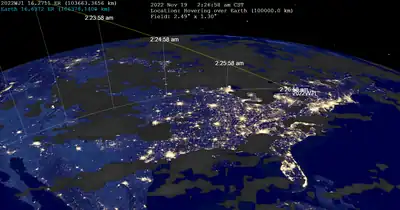 Simulated final trajectory estimate from JPL Horizons with 1 minute markers CST (UT-6hr) and lines down to surface. |
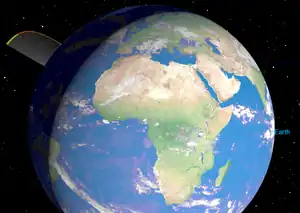 View from sunlit side of Earth. Without Earth's gravity, 2022 WJ1's trajectory would have missed Earth. Red markers show inside Earth's shadow. |
Orbit
The Apollo asteroid was inbound approaching a mid-December perihelion (closest approach to the Sun) when it impacted Earth.[5] Even at opposition on 15 October 2022 when 2022 WJ1 was 0.2 AU (30 million km; 78 LD) from Earth, it had an unobservable apparent magnitude of 31 which is about 600 times too faint to be detected by even the most sensitive automated allsky surveys.[7][lower-alpha 4]
2022 WJ1 orbited from inside Earth's orbit with perihelion at 0.92 AU to the middle of the asteroid belt at 2.8 AU.[5]
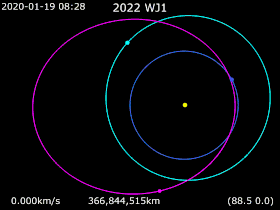
2022 WJ1 · Earth · Mars · Sun
See also
- Asteroid impact prediction
- Impact event
- 2022 EB5, the first predicted asteroid impact in 2022
Notes
References
- 1 2 3 4 5 "2022 WJ1". Minor Planet Center. Retrieved 19 November 2022.
- 1 2 3 "MPEC 2022-W69 : 2022 WJ1". Minor Planet Electronic Circulars. Minor Planet Center. 19 November 2022. Retrieved 19 November 2022.
- ↑ ""Pseudo-MPEC" for C8FF042". Project Pluto. 19 November 2022. Archived from the original on 19 November 2022. Retrieved 19 November 2022.
- 1 2 Whitt, Kelly Kizer (19 November 2022). "Asteroid hit Canada mere hours after discovery". EarthSky. Retrieved 19 November 2022.
- 1 2 3 4 5 "JPL Small-Body Database Browser: (2022 WJ1)". Jet Propulsion Laboratory. Archived from the original on 19 November 2022. Retrieved 19 November 2022.
- ↑ "Horizons Batch for previous perihelion in May 2020" (Perihelion occurs when rdot flips from negative to positive). JPL Horizons. Retrieved 19 November 2022.
- 1 2 "Horizons Batch for opposition October 2022". JPL Horizons. Retrieved 23 November 2022.
- 1 2 ESA C8FF042 (2:23 AM 19 Nov 2022)
- ↑ Astronomer Michael Busch (6:00 AM 19 Nov 2022)
- ↑ "Horizons Batch for Earth distance at 04:53". JPL Horizons. Retrieved 20 November 2022.
- ↑ Dr Robin George Andrews (5:46 PM 22 Nov 2022)
- ↑ "NASA Program Predicted Impact of Small Asteroid Over Ontario, Canada". NASA JPL. 22 November 2022. Retrieved 22 November 2022.
- ↑ "Minor Planets with Absolute Magnitudes 33 < H < 99". Minor Planet Center. Retrieved 19 November 2022.
- 1 2 3 "Meteorite Falls: Grimsby, Ontario". NASA Johnson Space Center Astromaterials Research & Exploration Science. Archived from the original on 20 November 2022. Retrieved 20 November 2022.
- 1 2 "Bright fireball may have dropped meteorites in Niagara region". Western University News. 21 November 2022. Retrieved 22 November 2022.
- 1 2 "Meteoritical Society: Grimsby (2009)". Meteoritical Society. Retrieved 22 November 2022.
- ↑ Holpuch, Amanda (19 November 2022). "Fireball Flashes Above Ontario and Parts of the U.S." The New York Times.
External links
- Fireball observers location map
- 2022 WJ1 at NeoDyS-2, Near Earth Objects—Dynamic Site
- 2022 WJ1 at ESA–space situational awareness
- 2022 WJ1 at the JPL Small-Body Database
- Interview with the asteroid's discoverer David Rankin
